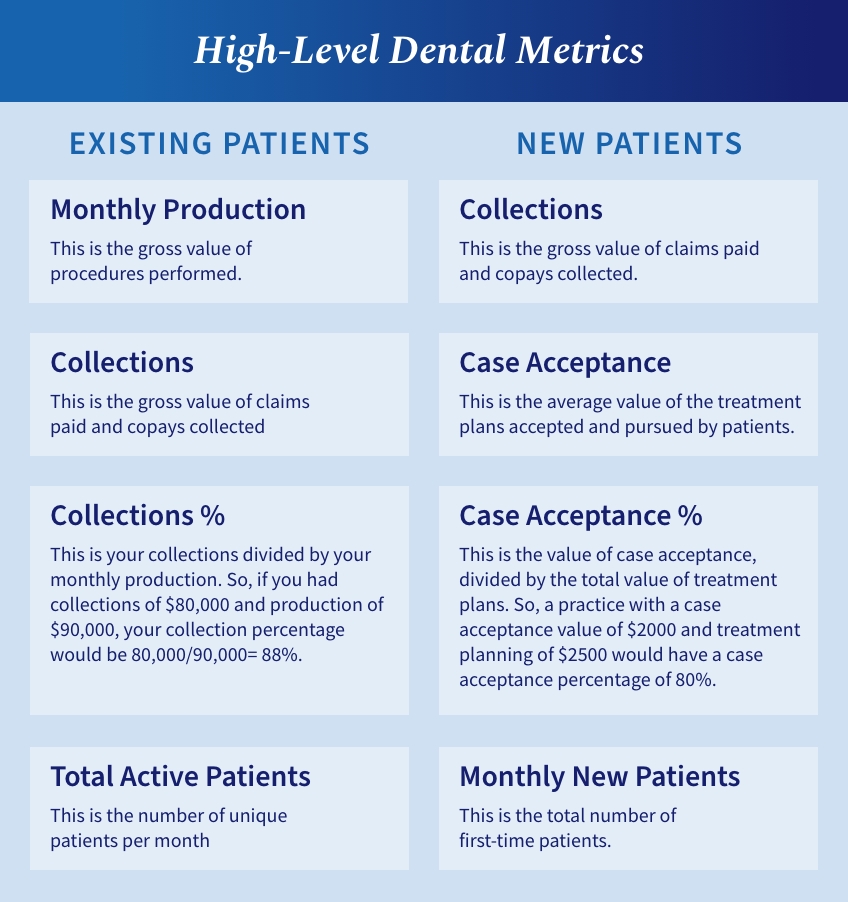Using Dental Metrics as Your Roadmap to Success

Metrics are a topic of conversation for every business today, but they pose a particular challenge in the dental industry. How are you supposed to measure abstract concepts like patient satisfaction or quality of care? Patients may provide details during their visits, but translating those into decision-making data is not always straightforward. It involves focusing on two types of dental metrics — big-picture drivers and the granular-level details that affect them.
Good dental metrics will not just tell you about the status of your practice. They will give insight into how you got there and how to build business resiliency. With the right system in place, you can create a roadmap to success.
High-level dental metrics for practice improvement
High-level dental metrics are built for goal setting. They provide the big-picture details that support practice growth. They can be broken down between existing and new patients.

These metrics are important, but they do not offer very much clarity as to why they are the way they are. Consider the case acceptance percentage. This number is often high due to short-term visits, such as tooth extractions. It may not accurately represent the practice’s true financial potential or its overall value drivers. For that, practices need to get deep into granular data, pulling metrics that help them understand what contributes to the above numbers.
The metrics dental practices need for planning

The above metrics are benchmarks. Consider the example for collections percentage in the prior section. That practice may set a goal to increase its collections percentage by 2%, which they know will represent about $1,600 more revenue for the office.
But how do they get there? For that, you must look deeper. Here are additional figures to consider when reviewing the collections percentage:
- Production per dentist: Production per dentist may be averaged over all the dentists at a practice, or it can be based on real practice data.
- Production per hygienist: Production by hygienists is the same, though it may be easier to base it on full working days rather than just the number of hygienists, as practices employ part-time or contract hygienists.
- Production by plan type: Practices can compare their production figures across treatment plan types to see what procedures create the most value.
- Insurance write off %: This is the average percentage of productions that are written off due to insurance fee schedule adjustments.
These smaller metrics give insight into how to improve that collections percentage. It can tell a practice whether it is making money in routine care, versus specialty services. It can also break down individual production values to guide impactful hiring decisions.
Of course, while those metrics are good for gaining insight, they do not address the human components of dentistry. Dental patients usually leave a practice because of soft skills. In fact, 48% of dental patients would consider changing dentists over a bad bedside manner or unfriendly staff. But how can dental metrics be used to address that component?
Addressing the human side of dentistry with data
Putting patient satisfaction, office culture, and abstract staffing information into actionable data is not easy – but it is possible. You just must know what to track. Here are dental metrics that provide insight into this less objective side of practice management:
- Business reviews/ratings: The internet has given businesses transparency that never existed before. Customers leave reviews on sights like Yelp, Google My Business, Healthgrades, and more. Data like this can be collected and reviewed to determine public perception of a practice and review areas of improvement.
- Staff turnover: How often is the practice losing and hiring staff? This helps practices understand the indirect costs of provider attrition and can trigger the need for a deeper review when these numbers are elevated.
- Patient attrition: How often are patients leaving the practice for good? Does this coincide with increased staff turnover? This information is critical for supporting practice growth.
- Staff training hours: This is the total number of hours staff participate in training every month, providing information on how well the practice is staying up to date.
- Staff training utilization: This is the training available compared to how often the staff uses it. This is critical for tracking employee engagement, as the most engaged employees are the ones who seek out training.
Of course, these metrics — and others like them — can be challenging to track as they are so practice-specific. Data on training also depends on the platform the practice provides. One that is not digitally enabled will not support significant levels of detail, which can create greater insights.
On top of that, it can be hard for practice managers and dentists to see their own data clearly. They will have personal biases that make it difficult to view metrics objectively. Often, it is best to collaborate with an outside consultant who can take a 360-degree view of a practice and then zoom in on the areas of the most importance.
Practice management software is highly advisable here. The right software will allow you to connect your specific metrics to employee and patient experiences. That can give you a visual roadmap of how you can enhance your practice and your workplace.
Tracking dental metrics is a vital part of practice management and the more granular you get, the better. By using a program that supports both objective and abstract practice data, you gain clear insight into your practices’ value drivers and areas of opportunity.
SPEAR NAVIGATOR
Transform how your practice runs by engaging the team through
coaching and training
A guided path to excellence through structured coaching and self-guided resources that will align your team, streamline processes and drive growth. Transform your practice by implementing Spear’s proven playbooks for developing and retaining a high-performing dental team.

By: Spear Team
Date: October 4, 2022
Featured Digest articles
Insights and advice from Spear Faculty and industry experts


